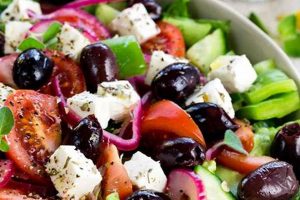The foundational version of this globally recognized salad traditionally comprises romaine lettuce, coddled eggs, croutons, Parmesan cheese, and a distinctive dressing made with ingredients such as garlic, lemon juice, Worcestershire sauce, and olive oil. Variations exist, but understanding the fundamental components allows for appreciation of its enduring appeal.
This classic formulation offers a balance of textures and flavors, from the crisp lettuce and crunchy croutons to the rich cheese and tangy dressing. Its creation in Tijuana, Mexico, in the early 20th century cemented its place in culinary history, and its subsequent popularity worldwide speaks to its timeless appeal. This groundwork serves as a springboard for countless adaptations and interpretations found in restaurants and homes today.
This exploration will delve into the specifics of ingredient selection, preparation techniques, and common variations, providing a deeper understanding of this culinary staple.
Tips for an Authentic Caesar Salad
Achieving an exceptional Caesar salad involves attention to detail and a focus on quality ingredients. The following tips provide guidance for preparing a truly remarkable dish.
Tip 1: Use Fresh, Crisp Romaine Lettuce: The foundation of any good Caesar salad lies in the lettuce. Choose crisp, cold romaine hearts and tear them into bite-sized pieces rather than chopping, as this prevents bruising and maintains a pleasant texture.
Tip 2: Coddle Eggs for a Richer Dressing: Coddled eggs contribute a creamy texture and unique flavor to the classic dressing. Briefly cooking the eggs creates a luxurious emulsion that elevates the overall experience.
Tip 3: Make Croutons from Scratch: Homemade croutons offer superior flavor and texture compared to store-bought alternatives. Use day-old bread, toss it with olive oil and seasonings, and bake until golden brown for optimal crunch.
Tip 4: Grate Parmesan Cheese Freshly: Pre-grated cheese often contains cellulose and other additives. Freshly grated Parmesan provides a superior flavor profile and melts more smoothly into the dressing.
Tip 5: Balance the Dressing’s Flavors: The dressing should be a harmonious blend of tangy, salty, and savory notes. Adjust the amounts of lemon juice, Worcestershire sauce, and garlic to achieve the desired balance.
Tip 6: Add the Dressing Gradually: Overdressing can make the salad soggy. Start with a small amount of dressing and add more as needed to lightly coat the leaves.
Tip 7: Serve Immediately: Caesar salad is best enjoyed fresh. Once dressed, the lettuce will begin to wilt, so serve and enjoy promptly.
By following these tips, one can create a Caesar salad that honors the integrity of the original formulation while delivering a truly satisfying culinary experience.
These insights provide a strong foundation for understanding the nuances of creating a truly exceptional Caesar salad. The following section will offer concluding thoughts and further inspiration.
1. Romaine Lettuce
Romaine lettuce forms the literal and figurative base of the original Caesar salad recipe. Its selection is not arbitrary; its properties contribute significantly to the salad’s overall character and are essential for an authentic experience. Understanding these contributions provides deeper insight into the dish’s composition.
- Texture and Structure:
Romaine’s sturdy leaves offer a satisfying crunch, contrasting with the creamy dressing and crunchy croutons. Its elongated, ribbed structure holds the dressing well without becoming soggy quickly, a crucial element for the salad’s enjoyment. Consider the difference between a crisp romaine leaf and a delicate butter lettuce leaf; the latter would simply collapse under the weight and richness of the Caesar dressing. This textural integrity is a defining feature of the original recipe.
- Flavor Profile:
Romaine possesses a subtly sweet and slightly bitter flavor that complements the assertive notes of the Caesar dressing. This balance prevents the salad from becoming overly rich or one-dimensional. The mildness of romaine allows the other ingredients, such as the garlic, anchovy, and Parmesan, to shine without being overpowered.
- Visual Appeal:
The vibrant green hue and elongated shape of romaine lettuce contribute to the salad’s visual appeal. Traditionally, whole leaves were used, creating an elegant presentation. This visual element is often lost in modern adaptations that use chopped romaine, highlighting a key distinction of the original recipe.
- Historical Significance:
The use of romaine lettuce in the original Caesar salad is not merely incidental; it is integral to its history and development. The availability and characteristics of romaine in the region where the salad originated likely influenced its inclusion, solidifying its place as the definitive lettuce for this iconic dish.
The careful consideration of romaine lettuce within the original Caesar salad recipe reveals its essential role. It is not simply a bed for the other ingredients; its unique characteristicstexture, flavor, appearance, and historical contextinterweave with the other components to create a harmonious and enduring culinary classic.
2. Coddled Egg
The coddled egg, a crucial component of the original Caesar salad recipe, contributes significantly to the dressing’s characteristic texture and flavor. Its inclusion distinguishes the authentic preparation from later variations and underscores the historical context of this culinary creation. A closer examination of the coddled egg’s role illuminates its importance in the overall composition of the original Caesar salad.
- Emulsification and Texture:
The gently cooked yolk of the coddled egg acts as an emulsifier, binding the oil and acidic elements of the dressing, creating a smooth, creamy consistency. This emulsification prevents the dressing from separating and contributes to its luxurious mouthfeel, coating the romaine leaves evenly. This characteristic texture is a defining feature of the authentic Caesar dressing, setting it apart from vinaigrette-based versions.
- Flavor Contribution:
The coddled egg introduces a subtle richness and depth of flavor to the dressing. Its slightly cooked state retains a delicate eggy flavor that complements the other ingredients without overpowering them. This nuance is absent in dressings that rely solely on raw egg yolks or omit eggs altogether.
- Historical Context:
The use of a coddled egg reflects the culinary practices and available resources at the time of the salad’s creation. It speaks to a resourcefulness and an understanding of how different ingredients interact to create a harmonious whole. This historical perspective adds depth to the appreciation of the original recipe.
- Distinction from Later Adaptations:
Many contemporary Caesar salad recipes substitute raw egg yolks or mayonnaise for the coddled egg due to concerns about food safety. While these alternatives may achieve a similar texture, they lack the distinct flavor profile imparted by the gently cooked egg, marking a departure from the original formulation.
The coddled egg’s contribution to the original Caesar salad recipe extends beyond mere functionality. It represents a key element that distinguishes the authentic experience, influencing the dressing’s texture, flavor, and historical significance. Understanding its role provides a deeper appreciation for the culinary artistry of this classic dish.
3. Croutons
Croutons contribute a crucial textural element to the original Caesar salad recipe, providing a contrasting crispness that complements the fresh romaine and creamy dressing. Their presence elevates the salad beyond a simple combination of ingredients, transforming it into a multi-dimensional culinary experience. The careful consideration given to crouton preparation in the original formulation underscores their significance.
The ideal crouton for a Caesar salad possesses a delicate balance: a crisp exterior yielding to a soft interior. Achieving this texture requires using day-old bread, preferably a rustic loaf with a substantial crumb. The bread is typically cut into bite-sized pieces, tossed with olive oil and seasonings, and then baked or pan-fried until golden brown. This method ensures that the croutons retain their structure while contributing a subtle toasted flavor that harmonizes with the other components of the salad. Using freshly baked bread often results in croutons that are too soft and quickly become soggy when exposed to the dressing, detracting from the intended textural contrast.
The historical context surrounding the inclusion of croutons offers further insight into their importance. Resourcefulness in utilizing day-old bread aligns with the spirit of the original recipe’s creation. The croutons are not merely a decorative afterthought but rather a deliberate addition that enhances both the textural and flavor profile of the salad. Furthermore, the act of preparing croutons from scratch, as opposed to using commercially produced versions, reflects a commitment to quality and attention to detail that characterizes the authentic Caesar salad experience.
4. Parmesan Cheese
Parmesan cheese constitutes an essential component of the original Caesar salad recipe, contributing a distinct sharp, salty flavor and a pleasing granular texture. Its presence is not merely incidental; it plays a crucial role in balancing the other flavors and textures, elevating the salad from a simple combination of ingredients to a complex and harmonious culinary creation. Understanding Parmesan’s specific contributions provides deeper insight into the recipe’s overall composition.
- Flavor Profile:
Parmesan, a hard, granular cheese, possesses a complex flavor profile characterized by sharp, salty, and umami notes. This sharpness cuts through the richness of the dressing and the subtle sweetness of the romaine, providing a crucial balance. The unique umami flavor, derived from the long aging process, adds depth and complexity, further enhancing the overall taste experience. Substituting other cheeses compromises this delicate balance, altering the fundamental character of the salad.
- Textural Contribution:
The granular texture of Parmesan adds a pleasing counterpoint to the crisp romaine and crunchy croutons. When freshly grated, the cheese clings to the leaves, ensuring that each bite delivers a burst of its characteristic flavor. This textural interplay is essential to the original recipe’s success, and pre-grated or powdered Parmesan often lacks the same impact, detracting from the intended sensory experience.
- Historical Significance:
The inclusion of Parmesan in the original Caesar salad recipe reflects the availability of ingredients and culinary influences present at the time of its creation. This historical context underscores the importance of using authentic Parmesan cheese, as opposed to imitations, to maintain the integrity of the dish.
- Interaction with other Ingredients:
Parmesan interacts synergistically with the other components of the Caesar salad. Its saltiness enhances the flavors of the anchovy and garlic in the dressing, while its umami notes complement the richness of the coddled egg. This interplay highlights the careful consideration given to the selection and balance of ingredients in the original recipe.
The role of Parmesan cheese in the original Caesar salad extends beyond simply adding flavor; it represents a carefully chosen element that contributes significantly to the overall balance, texture, and historical authenticity of the dish. Recognizing the nuances of its contribution provides a deeper appreciation for the culinary artistry of this classic creation. A Caesar salad without genuine Parmesan is not a true Caesar salad; it is a variation that misses a crucial dimension of the original experience.
5. Caesar Dressing
Caesar dressing is not merely an accompaniment to the original Caesar salad; it is an integral component that defines its character and distinguishes it from other salads. A thorough understanding of this dressing, its ingredients, preparation, and historical context, is essential for appreciating the nuances of the original recipe. This exploration will delve into the key facets that connect Caesar dressing to the authentic Caesar salad experience.
- Emulsification and Texture:
The original Caesar dressing distinguishes itself through its emulsified texture, a result of the coddled egg yolk acting as a binding agent between the oil and acidic elements. This creates a creamy, cohesive dressing that clings to the romaine leaves, delivering a rich mouthfeel and ensuring an even distribution of flavor. This emulsification is a key characteristic absent in simpler vinaigrette-style dressings often substituted in contemporary adaptations.
- Flavor Profile:
The flavor profile of authentic Caesar dressing is a complex interplay of savory, tangy, and umami notes. Anchovies contribute a subtle salty, savory depth, while garlic provides a pungent bite. Lemon juice introduces a bright acidity, balancing the richness of the other ingredients. Worcestershire sauce adds a layer of complexity with its blend of spices and fermented flavors. This intricate balance of flavors is crucial to the original recipe, creating a distinctive taste experience that sets it apart.
- Preparation Technique:
The traditional preparation of Caesar dressing involves a specific technique of gradual emulsification. The coddled egg yolk is combined with garlic, lemon juice, Worcestershire sauce, and seasonings. Olive oil is then slowly whisked in, drop by drop initially, to create a stable emulsion. This method ensures a smooth, creamy texture and prevents the dressing from separating. Modern shortcuts, such as using a blender or substituting mayonnaise, often compromise the delicate balance and texture of the original.
- Historical Context:
The original Caesar dressing, as conceived by Caesar Cardini, reflected the available ingredients and culinary influences of its time and place. Its evolution and subsequent adaptations provide a glimpse into changing culinary practices and preferences. Understanding this historical context emphasizes the significance of adhering to the original formulation to preserve the authenticity of the dish. Contemporary versions often stray from the original, incorporating ingredients like Dijon mustard or altering the balance of flavors, resulting in a dressing that bears little resemblance to Cardini’s creation.
The connection between Caesar dressing and the original Caesar salad recipe is inextricable. The dressing is not merely a topping but a defining characteristic, contributing significantly to its unique flavor, texture, and historical identity. Appreciating the nuances of the original dressing formulation provides a deeper understanding and respect for this culinary classic, distinguishing it from the myriad variations that exist today.
6. Tijuana Origins
The Caesar salad’s origin in Tijuana, Mexico, is integral to understanding its authentic form. Attributing its creation to Caesar Cardini at his Tijuana restaurant in the 1920s provides a specific cultural and historical context. This context informs not only the recipe itself but also its subsequent evolution and global dissemination. The scarcity of certain ingredients during a busy weekend purportedly led to Cardini’s improvisation with available resources, resulting in the now-iconic salad. This narrative of resourcefulness and spontaneous creation adds a layer of significance beyond the mere combination of ingredients.
The Tijuana setting influenced the original recipe in several ways. The availability of local ingredients, such as romaine lettuce and Parmesan cheese, likely shaped Cardini’s choices. Furthermore, the vibrant culinary landscape of Tijuana, a border city influenced by both Mexican and American traditions, may have played a role in the salad’s development. Consider, for example, the use of Worcestershire sauce, a British condiment that found its way into Mexican cuisine through trade and cultural exchange. This fusion of influences underscores the unique character of the original Caesar salad, distinguishing it from purely Italian or American salads. Examining the historical culinary trends in Tijuana provides a richer understanding of the dish’s emergence and subsequent popularity.
Understanding the Tijuana origins of the Caesar salad provides a framework for appreciating its authentic preparation. Recognizing the historical context allows one to distinguish between the original recipe and later adaptations that may deviate significantly from Cardini’s creation. This knowledge empowers culinary enthusiasts to recreate the salad with a greater degree of accuracy and respect for its historical significance. The Tijuana connection adds a layer of cultural richness and depth to the culinary experience, transforming the act of preparing and consuming a Caesar salad into an engagement with history and tradition. It emphasizes the importance of acknowledging culinary origins and the influence of place on gastronomic innovation.
Frequently Asked Questions
The following addresses common inquiries regarding the original Caesar salad recipe, clarifying potential misconceptions and providing further insight into its authentic preparation.
Question 1: Does authentic Caesar salad dressing contain raw eggs?
While some modern adaptations use raw egg yolks, the original recipe employed a coddled egg, briefly cooked to a safe temperature while retaining its emulsifying properties and contributing a distinct flavor.
Question 2: Why is romaine lettuce specified in the original recipe?
Romaine lettuce provides the ideal balance of crisp texture and subtle flavor, complementing the richness of the dressing without becoming soggy. Its structural integrity is crucial to the salad’s overall composition.
Question 3: Are anchovies a necessary ingredient in the original Caesar dressing?
Anchovies are indeed a key component of the original dressing, contributing a savory depth and umami note that balances the other flavors. Their presence is essential for an authentic flavor profile.
Question 4: Can bottled Caesar dressing replicate the original flavor?
Bottled dressings often contain preservatives, stabilizers, and flavor enhancers that deviate significantly from the fresh, nuanced flavor profile of the original Caesar dressing.
Question 5: What distinguishes homemade croutons from store-bought varieties in a Caesar salad?
Homemade croutons, prepared with day-old bread and seasoned appropriately, offer a superior texture and flavor compared to commercially produced alternatives, contributing significantly to the overall sensory experience.
Question 6: Where did the Caesar salad originate?
The Caesar salad originated in Tijuana, Mexico, at Caesar Cardini’s restaurant in the 1920s. This historical context is crucial for understanding the recipe’s authentic form and subsequent variations.
Understanding these key aspects of the original Caesar salad recipe allows for a deeper appreciation of its unique qualities and enduring legacy. The following section offers further exploration of variations and modern interpretations.
The exploration of these frequently asked questions provides a clearer understanding of the original Caesar salad recipe. Now, we will delve into common variations and adaptations that have emerged over time.
Original Caesar Salad Recipe
This exploration has delved into the specifics of the original Caesar salad recipe, highlighting the crucial role of each componentfrom the crisp romaine lettuce and creamy coddled egg to the freshly grated Parmesan and perfectly balanced dressing. The historical context surrounding its creation in Tijuana, Mexico, further enriches our understanding of this iconic dish. By examining the authentic preparation methods and ingredients, one gains a deeper appreciation for the culinary artistry involved and the enduring appeal of this classic salad.
The original Caesar salad recipe serves as a testament to the power of culinary innovation and the enduring influence of tradition. While variations abound, understanding the foundational elements allows for a more informed appreciation of this dish and its continued relevance in the culinary landscape. This knowledge empowers both professional chefs and home cooks to recreate an authentic experience, preserving a piece of culinary history while enjoying a timeless classic.






